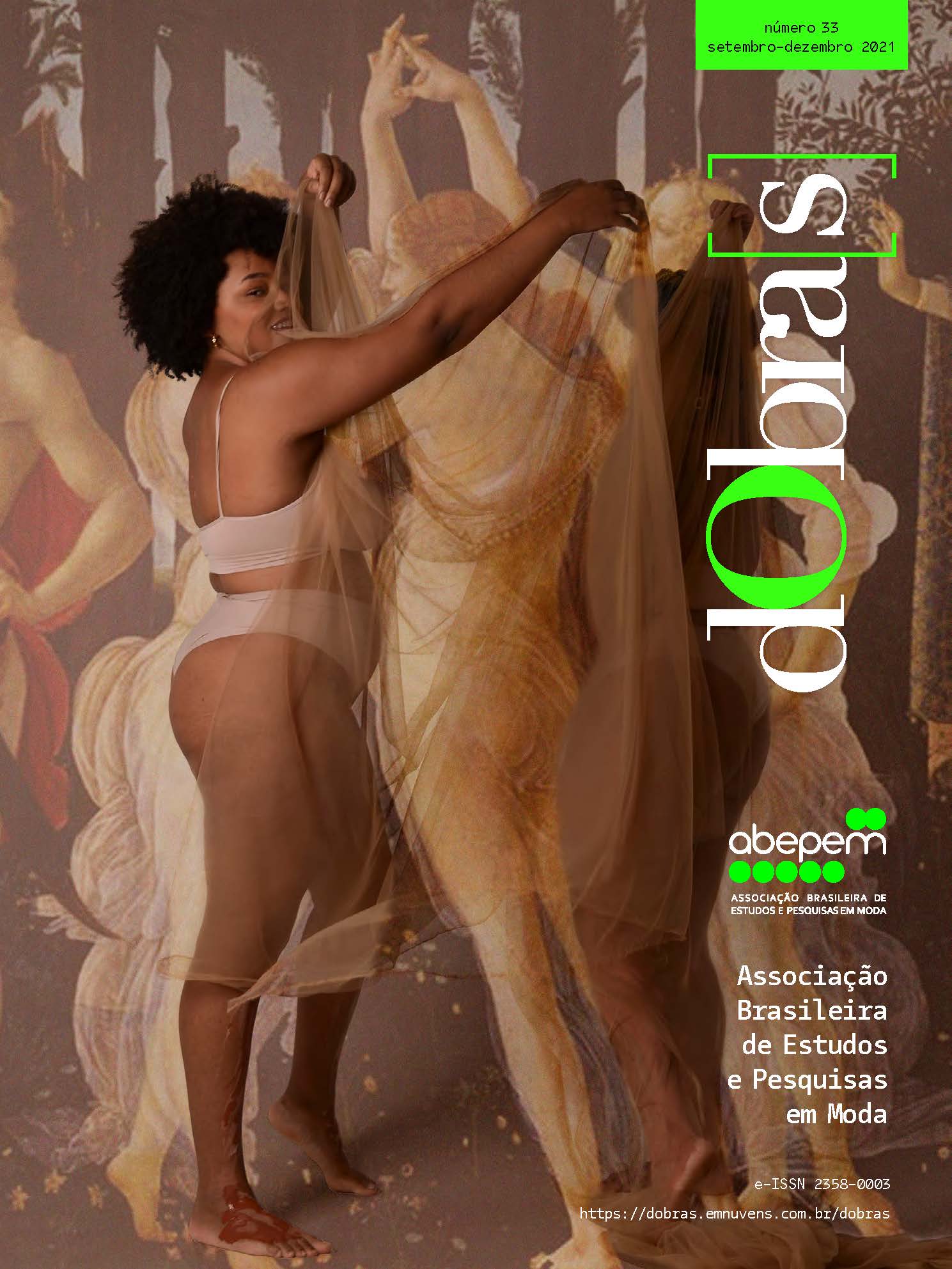Her name is Jenifer
fat representativity matters
DOI:
https://doi.org/10.26563/dobras.i33.1430Keywords:
Fatphobia, Fat representation, Communication and art, MediaAbstract
Although fatphobia is understood as the prejudice against fat people, such prejudice is experienced in a much more visceral way among women. The stigma of weight in contemporary society and the media representations of fat women operate in a kind of tug of war, sometimes tending more to one side, sometimes to the other. When studying such representations in a research that combines literature review and content analysis in a complex perspective, it was understood that the idea of fat corporealities permeates precisely the way they are represented in the media, including in this context their clothes. This paper presents, in addition to some of the mechanisms of action of fatphobia in the relationship of weight with the media, a way of deconstructing this prejudice from the non-stigmatized media representation of the fat body, having as example the clip of Jenifer, song by Gabriel Diniz, whose interpretation of the main character was on Mariana Xavier, a fat woman. Issues related to beauty standards with regard to female body size in different cultural contexts are addressed in a study that extrapolates the interrelationships between fat, race and class and whose objective is not only to inscribe fatphobia as an object of studies in the field of communication and arts, as well as promoting the reflection that the deconstruction of this prejudice and the (re)appropriation and reframing of this body necessarily involves the representation of fat women in the most diverse ways and in the most diverse spaces.
Downloads
References
ABL, Academia Brasileira de Letras. Palavra da Semana: Gordofobia. In Facebook. 15 fev. 2021. Disponível em: https://bit.ly/3mIcxrM. Acesso em 13 abr. 2021.
AIRES, Aliana Barbosa. De gorda à pluz size: a produção biopolítica do corpo nas culturas do consumo - entre Brasil e EUA. 2019. 2019. [230 f.]. Tese (Programa de Doutorado em Comunicação e Práticas de Consumo) - Escola Superior de Propaganda e Marketing, [São Paulo].
ARRUDA, Agnes de Sousa. O peso e a mídia: uma autoetnografia da gordofobia sob o olhar da complexidade. Tese (Doutorado em Comunicação). Universidade Paulista – UNIP. São Paulo, 2019.
ARRUDA, Agnes de Sousa; MIKLOS, Jorge. O PESO E A MÍDIA: Estereótipos da Gordofobia. In Revista Líbero. Ano XXIII - N.° 46. Jul./Dez. 2020.
BAITELLO Jr. Norval. Comunicação, Mídia e Cultura. In São Paulo em Perspectiva. V. 12, nº 04, Comunicação e Informação, Out-Dez. 1998. Disponível em https://cutt.ly/NvdXHWG. Acesso em 8 jun. 2015.
BALBINO, Jéssica. Quando eu emagrecer, vou ser feliz. In Peita. 28 jul. 2021. Disponível em: https://bit.ly/3pEg3XO. Acesso em 27 out. 2021.
BARDIN, Laurence. Análise de conteúdo. Lisboa: Edições 70, 1988.
CABRAL, Muniz Sodré de Araújo. Antropológica do espelho: uma teoria da comunicação linear e em rede. Petrópolis, RJ: Vozes, 2002.
DINIZ, Gabriel. O nome dela é Jenifer. 21 set. 2018. Disponível em: https://cutt.ly/vvdQDbe. Acesso em 10 abr. 2020.
ELLIS, Carolyn; ADAMS, Tony E.; BOCHNER, Arthur P. Autoethnography: An Overview. In Forum Qualitative Sozialforschung / Forum: Qualitative Social Research, Vol 12, Nº 1 (2011). Disponível em https://cutt.ly/rvdQJJX. Acesso em 19 out. 2018.
GOFFMAN, Erving. Estigma: notas sobre a manipulação da identidade deteriorada. São Paulo: LTC, 1988.
GREER, Germane. A mulher total. Lisboa: Editorial Notícias, 1999.
LAUS, Maria Fernanda. Influência do padrão de beleza veiculado pela mídia na satisfação corporal e escolha alimentar de adultos. Tese (Doutorado em Psicobiologia) - Faculdade de Filosofia, Ciências e Letras de Ribeirão Preto, Universidade de São Paulo, Ribeirão Preto, 2013.
MESTRE, Natália. A sibutramina, remédio pra emagrecer, matou minha irmã, diz publicitária. In Glamour. 1 mar. 2016. Disponível em: https://glo.bo/3aQpyYJ. Acesso em 22 mar. 2017.
MORIN, Edgar. Cultura de Massas no século XX: Neurose. 9. Ed. Rio de Janeiro: Forense Universitária, 1997.
MORIN, Edgar. Introdução ao pensamento complexo. 3. ed. Porto Alegre: Sulina, 2005.
SANCHES, Rodrigo Daniel. Corpus Alienum: efeitos do discurso das novas dietas, corpoprojeto e mídia. 2018. Tese (Doutorado em Psicologia: Processos Culturais e Subjetivação) - Faculdade de Filosofia, Ciências e Letras de Ribeirão Preto, Universidade de São Paulo, Ribeirão Preto, 2018.
NICOLOSI, Regina. Naturalidade sem natureza: a construção da mulher como simulacro na revista Plástica & Beleza. Dissertação (Mestrado em Comunicação). Universidade Paulista – UNIP. São Paulo, 2018.
O DIA. Mais de 60% dos jovens brasileiros dizem estar insatisfeitos com o corpo. 17 jun. 2012. Disponível em https://cutt.ly/wvdCt2n. Acesso em 22 mar. 2017.
QUEBRANDO o tabu. O nome dela é Jenifer. 30 jan. 2018. Disponível em https://bit.ly/2Q5Kk2j. Acesso em 29 abr. 2019.
VELHO, Gilberto (organizador). Desvio e divergência: uma crítica à patologia social. 5. ed. Rio de Janeiro: Jorge Zahar, 1985.
VOMERO, Maria Fernanda. Por que uma pessoa se mata? 31 dez. 2002. Disponível em https://bit.ly/32jCaFW. Acesso em 20 mar. 2017.
XAVIER, Mariana. Canal no YouTube. https://cutt.ly/PvdAHbn. Acesso em 15 abr. 2021.
WHO, World Helth Organization. Physical status: the use and interpretation of anthropometry. Geneva: Switzerland, 1995. Disponível em: https://bit.ly/2FahUyf. Acesso em 25 fev. 2021.
WOLF, N. O mito da beleza: como imagens de beleza são usadas contra as mulheres. 10. Ed. Rio de Janeiro: Rosa dos Tempos, 2020.
ZANIN, Tatiana. Entenda o que é anorexia alcoólica. Disponível em https://bit.ly/3sl2Uke. Acesso em 22 mar. 2017.
Downloads
Published
How to Cite
Issue
Section
License

This work is licensed under a Creative Commons Attribution-NonCommercial-ShareAlike 4.0 International License.
The copyrights of the works published in this journal belong to the author, and dObra[s] holds the rights of first publication. Due to their publication in this open access journal, any work here is free to use, with its own attributions, in educational and non-commercial applications.










